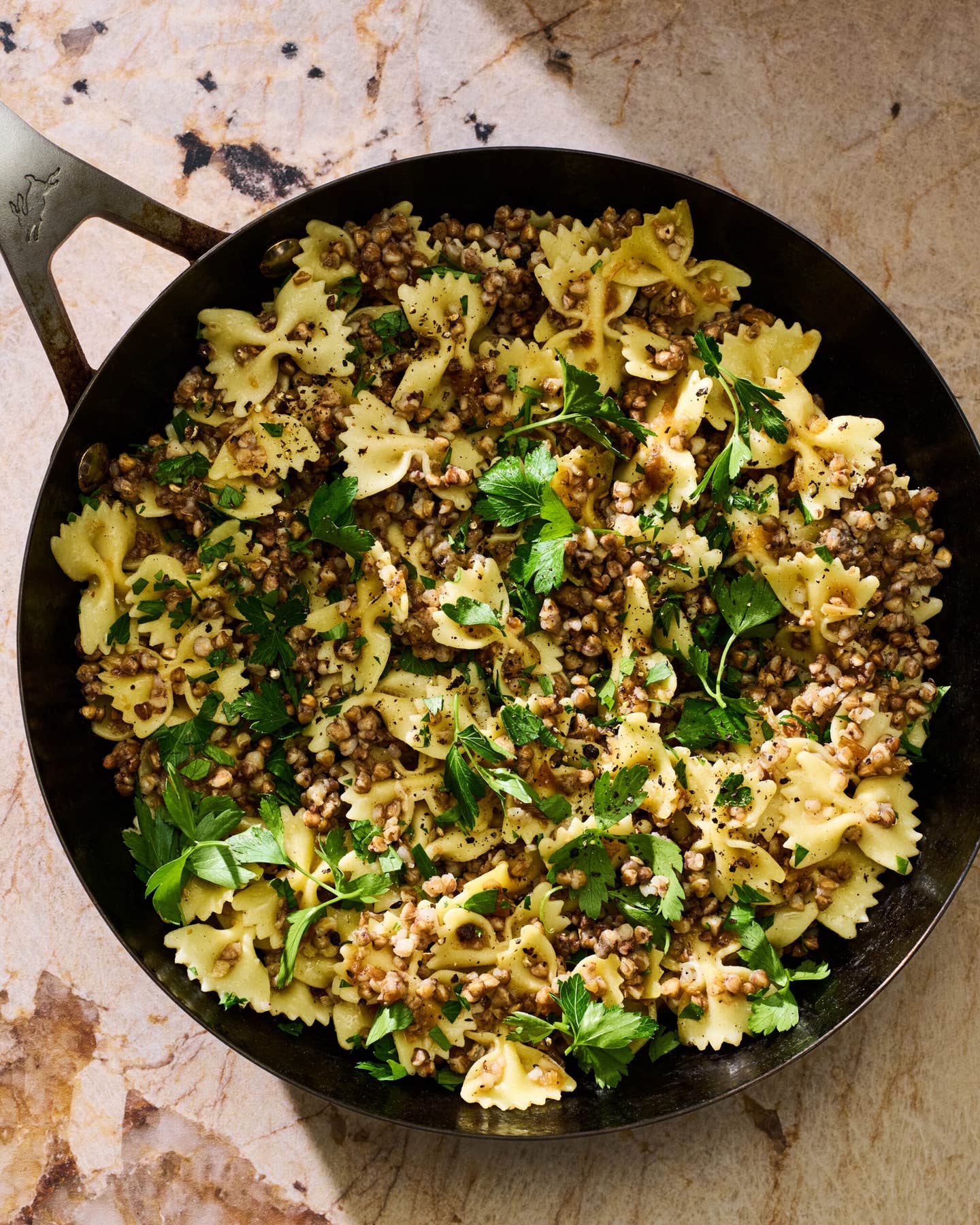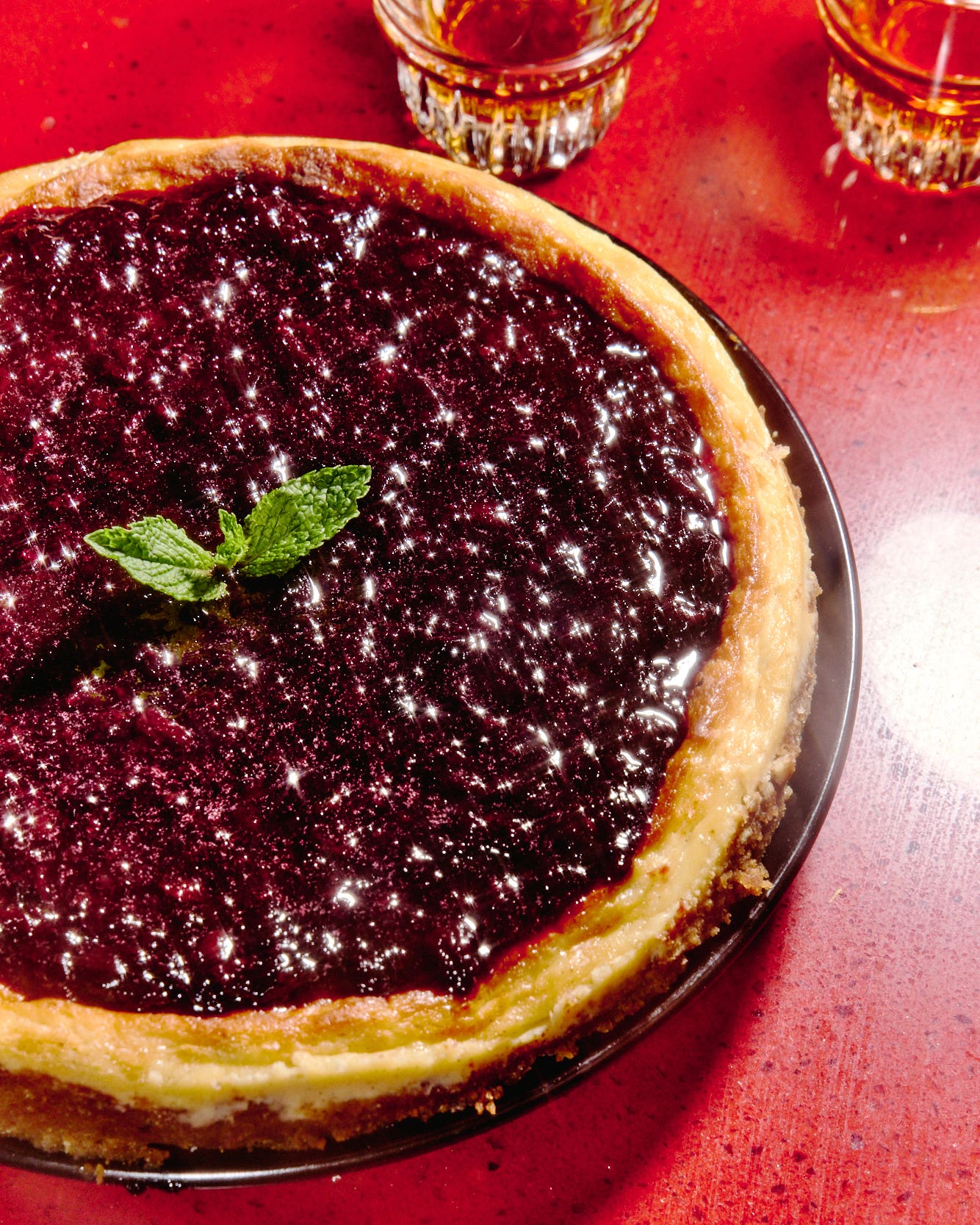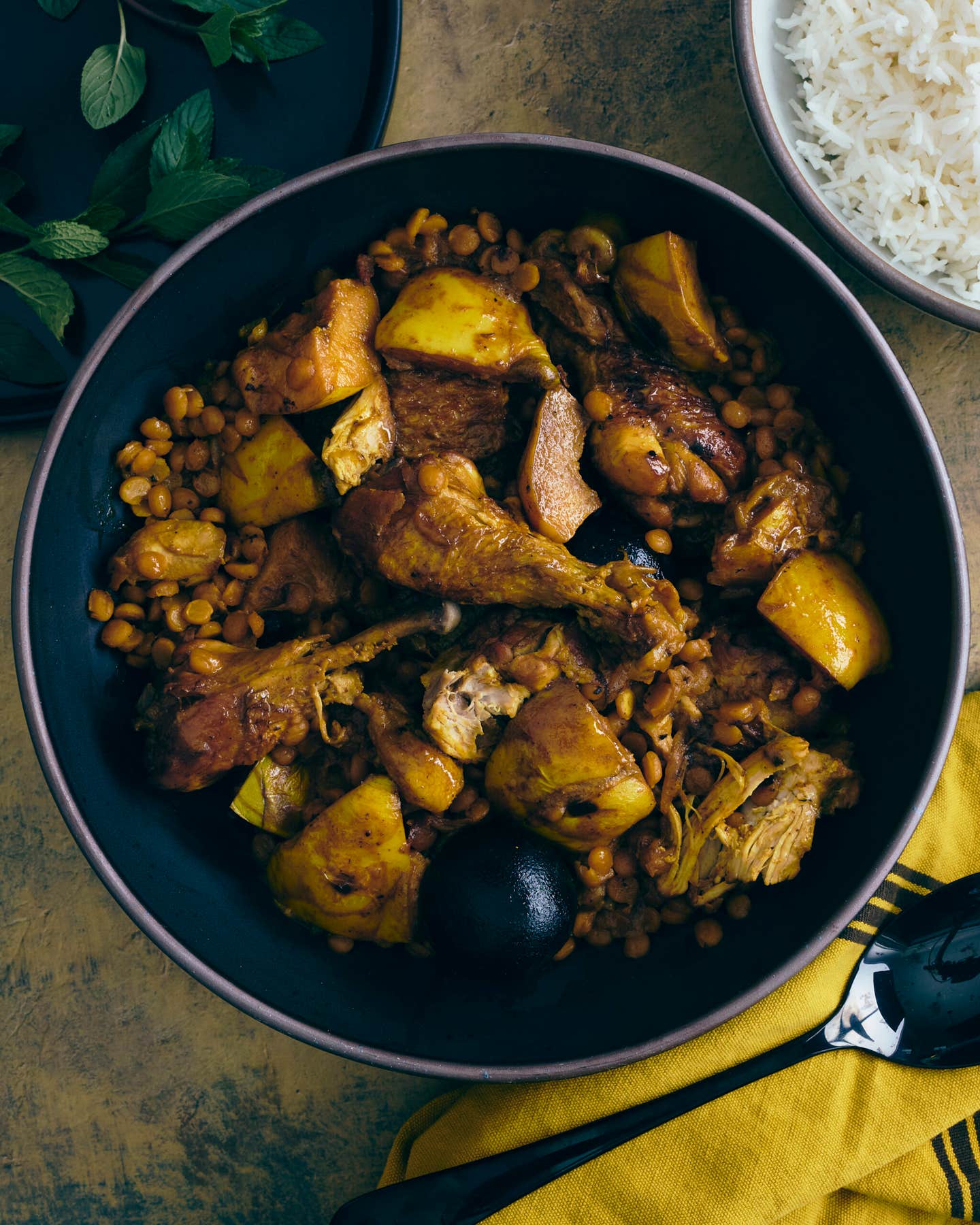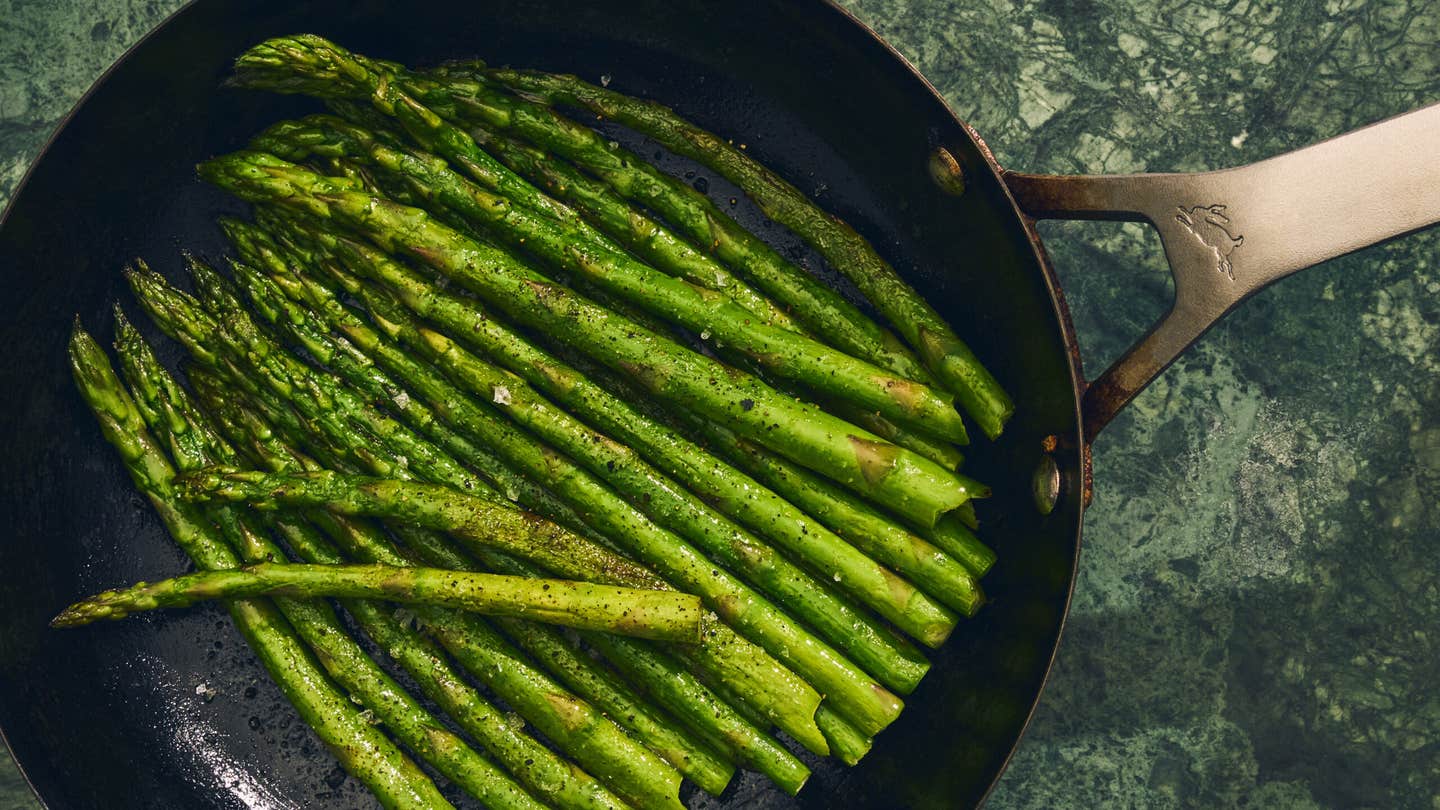
24 Asparagus Recipes That Taste Like Pure Spring
Everything from raw salads and chilled soups to cheesy casseroles and one-pot pastas.
This time of year, when asparagus floods the farmers markets, we can’t get enough of the bright, crunchy stalks. While decent asparagus is available year-round, the out-of-season stuff can carry a distinct cardboardy flavor, an unfortunate result of its long-distance voyage. In the springtime, however, with just a remnant of winter’s chill still in the ground, the stalks are loaded with flavor—grassy and complex, sweet and astringent.
In her iconic vegetable cookbook, The New Vegetarian Cooking for Everyone, Deborah Madison recommends looking for upright, firm stalks. The tips, which are the most delicate part, are the first to show signs of spoilage and, as Madison explains, “should be closed, compact, appearing neither excessively dry nor damp.” Stalks should be crisp, firm, and smooth, with little to no bruising or shriveling.
In Lulu’s Provençal Table, the late Richard Olney wrote of winemaker Lulu Peyraud’s treatment of wild asparagus, “no thicker than heavy twine,” and with a flavor that was “wild, a concentrated essence of asparagus with an exhilarating bitter edge.” Only the very ends of the rugged crop were tender enough to eat, so Lulu would either sauté them briefly in olive oil before adding them to an omelet, or blanch the whole stalks to serve as an elegant appetizer, drizzled with olive oil and salt. “Guests pick up a stalk,” she says, “bite off the tender tip, and discard the rest.”
Chef Kevin Johnson of The Grocery, a local favorite in Charleston, South Carolina, serves a mean rib eye, but the former vegetarian has become particularly renowned for his thoughtful vegetable dishes. In the spring, Johnson’s walk-in cooler is filled to the brim with asparagus, which he stores upright in a few inches of ice water, like freshly cut flowers. Johnson prefers using dry cooking techniques on asparagus (or even leaving it raw). Asparagus, he believes, “just tastes better when it doesn’t touch water,” which he feels washes away its “subtle, vegetal qualities.” Whether you’re in the classic blanch-and-shock camp or more inclined to skip the water à la Johnson, we’ve got you covered with our favorite asparagus recipes.
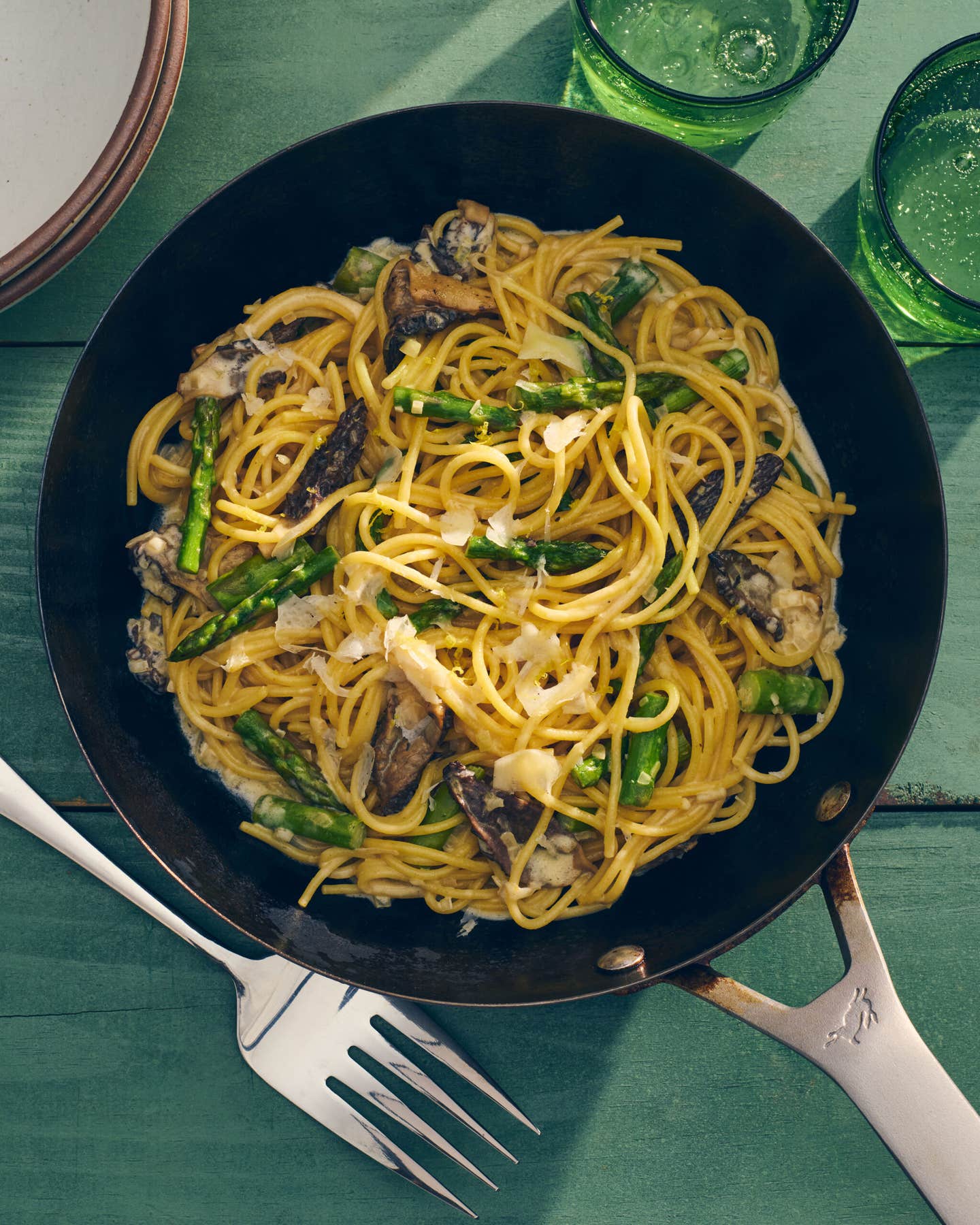
Asparagus shares top billing with another seasonal ingredient in this bright spring pasta dish: morels. You can use fresh or dried mushrooms, and a lemony parmesan cream sauce ties the whole thing together. Get the recipe >
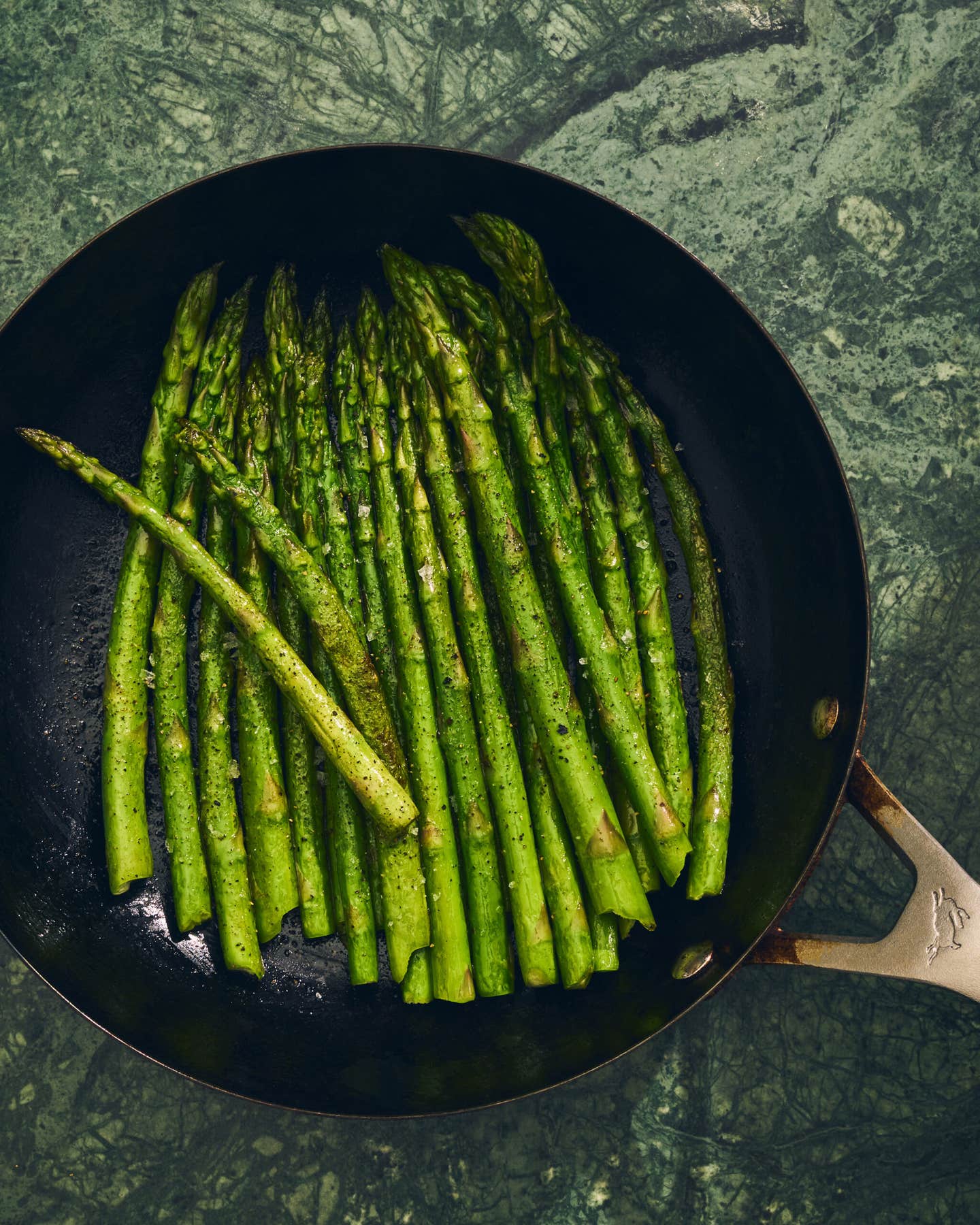
This quick and easy stovetop asparagus from celebrated Southern chef Edna Lewis is one of our most popular recipes of all time for a reason: it works every time. All you need is a skillet, a little butter, and the freshest asparagus you can find. Get the recipe >

Not only are we obsessed with the dainty, ladies-who-lunch name of this recipe, but we also can’t get enough of its comforting flavors. Asparagus is layered with creamy béchamel and sliced hard-boiled eggs, finished with a cheesy bread and cracker topping, and baked into the most glorious golden casserole. Get the recipe >
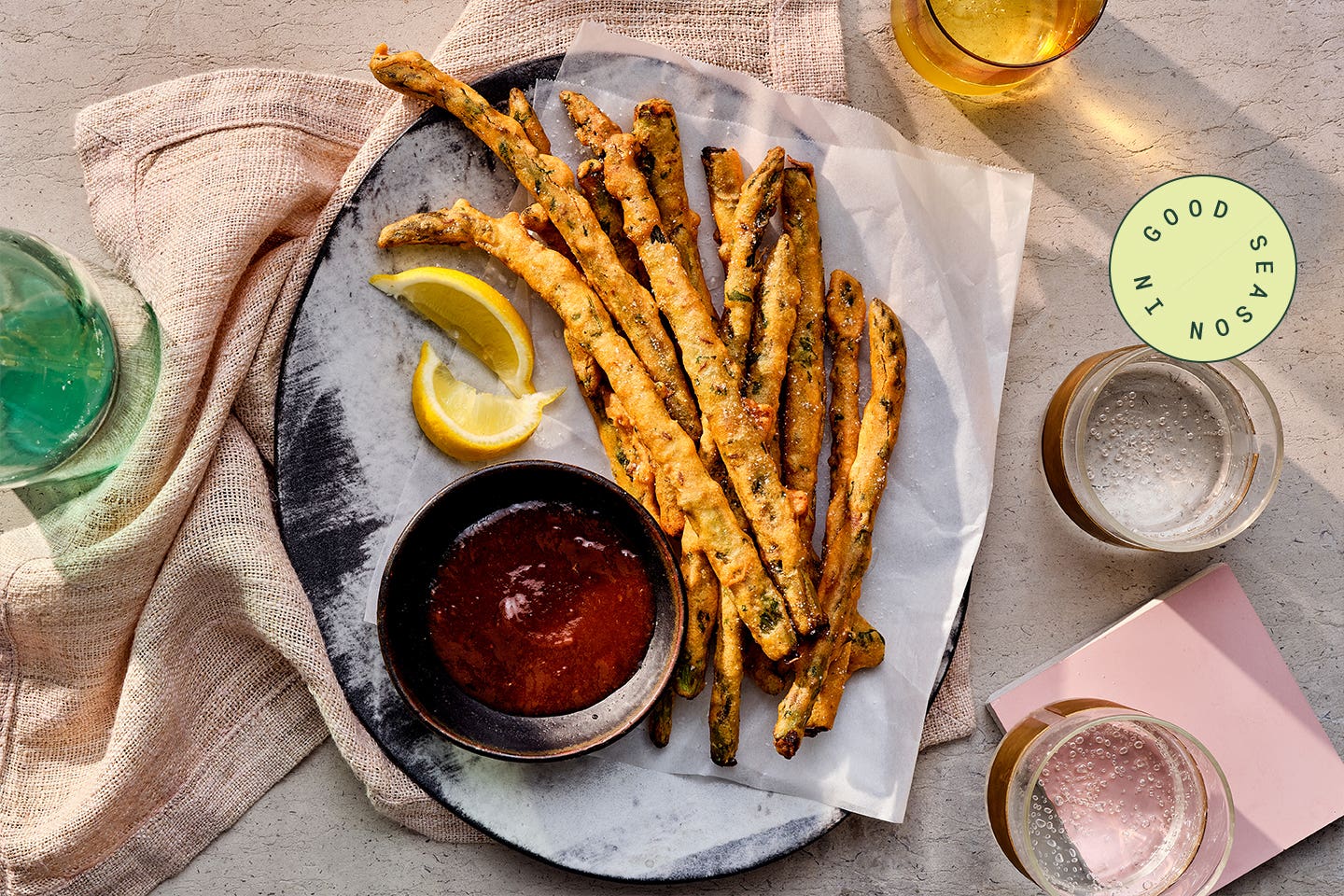
For this springtime take on the beloved South Asian street food, asparagus spears are coated in light chickpea batter and fried until crisp and golden. Add a sprinkle of salt and a squeeze of lemon, then devour them hot. Get the recipe >

Asparagus is briefly blanched to capture its sweetness, then tossed with butter lettuce, chives, fennel, radishes, ricotta salata, and pickled rhubarb. Bulked up with hearty spelt, it’s the grain bowl to end all grain bowls. Get the recipe >
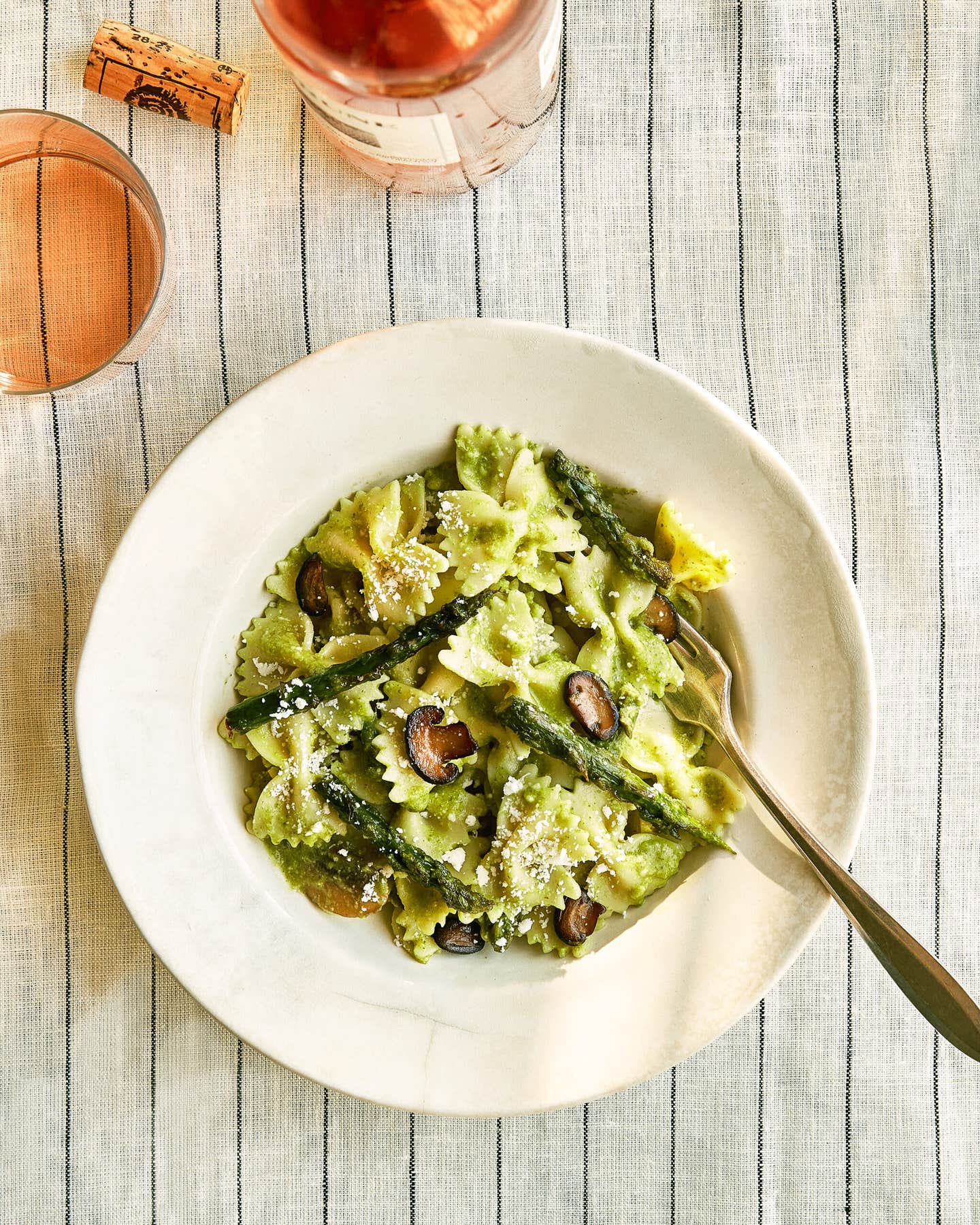
Asparagus pulls double duty in this one-pot wonder: The stalks are transformed into a green sauce along with arugula and peas, and the tips are sautéed with mushrooms for the topping. Get the recipe >
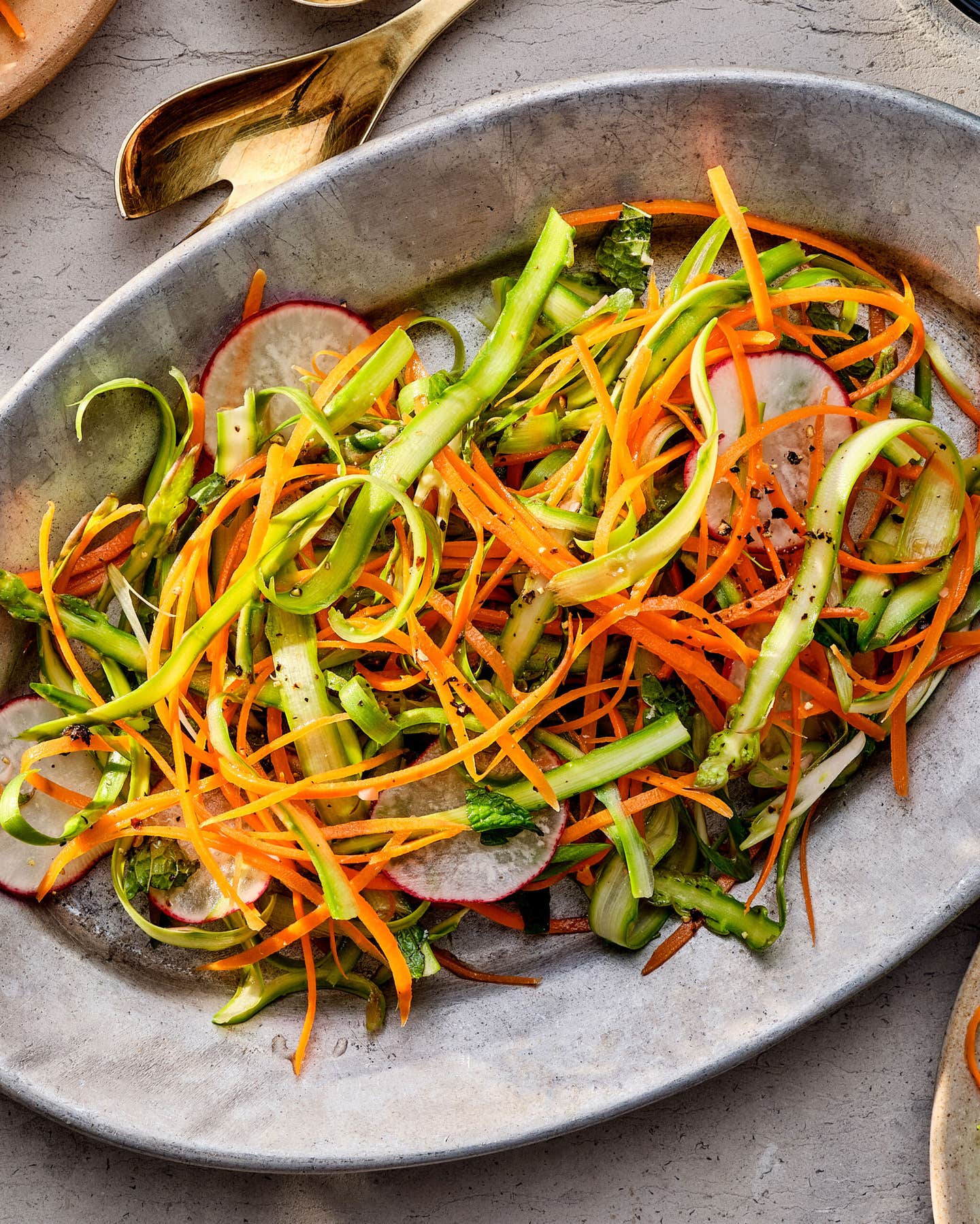
Raw asparagus deserves your attention! Here, it’s shaved into ribbons and tossed with carrots, radishes, scallions, mint, and a red wine vinaigrette for a sensational salad. Get the recipe >
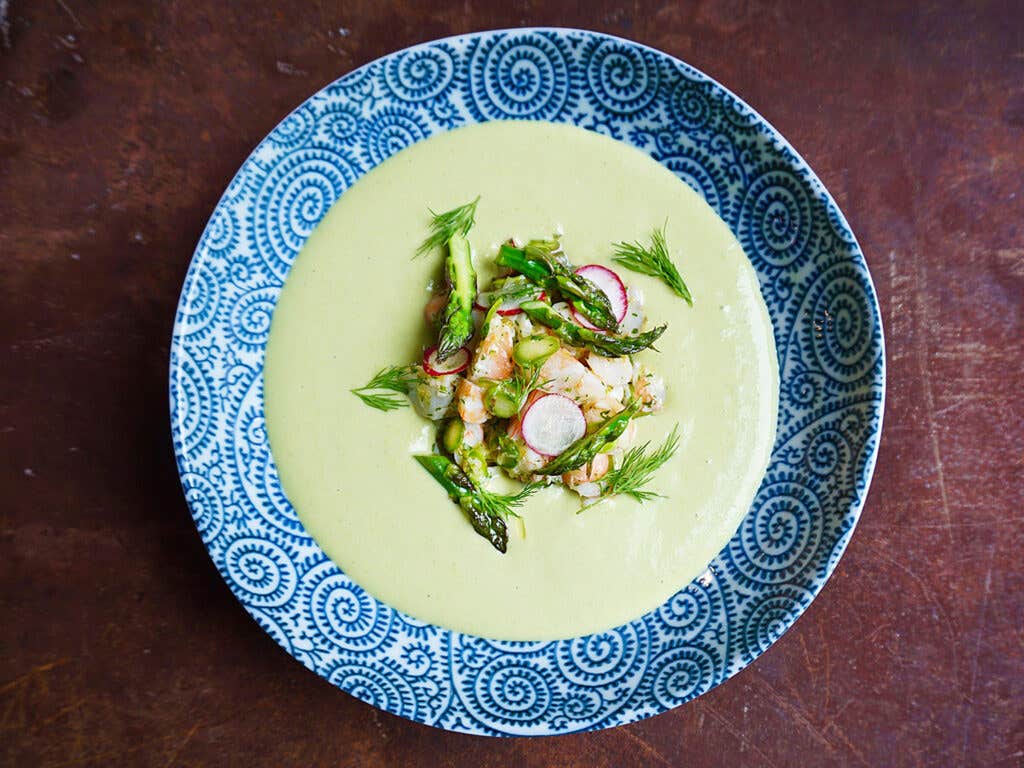
Don’t toss the tough parts of the asparagus! The flavorful trimmings are perfect for soups like this springtime vichyssoise, which is topped with a colorful salad of asparagus tips, radishes, poached shrimp, and fresh herbs. Get the recipe >
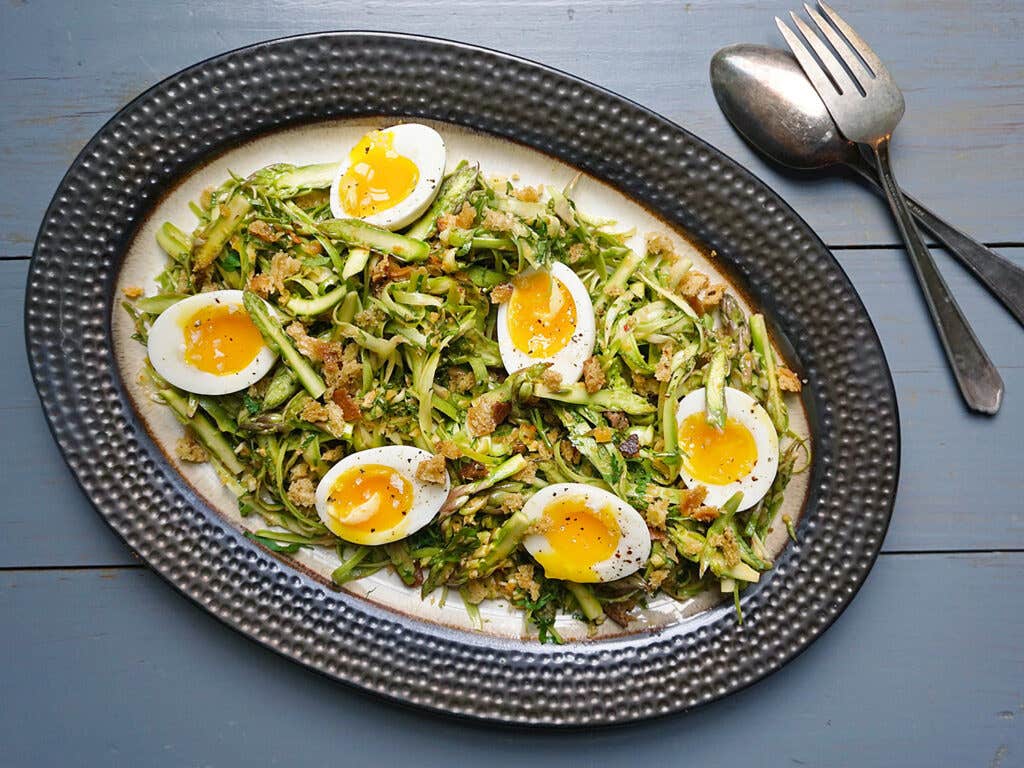
Ribbons of raw asparagus are dressed in a lively Roman-style vinaigrette—punctuated with umami-rich capers and anchovies—and topped with jammy soft-boiled eggs and crunchy sourdough breadcrumbs in this satisfying starter. Get the recipe >
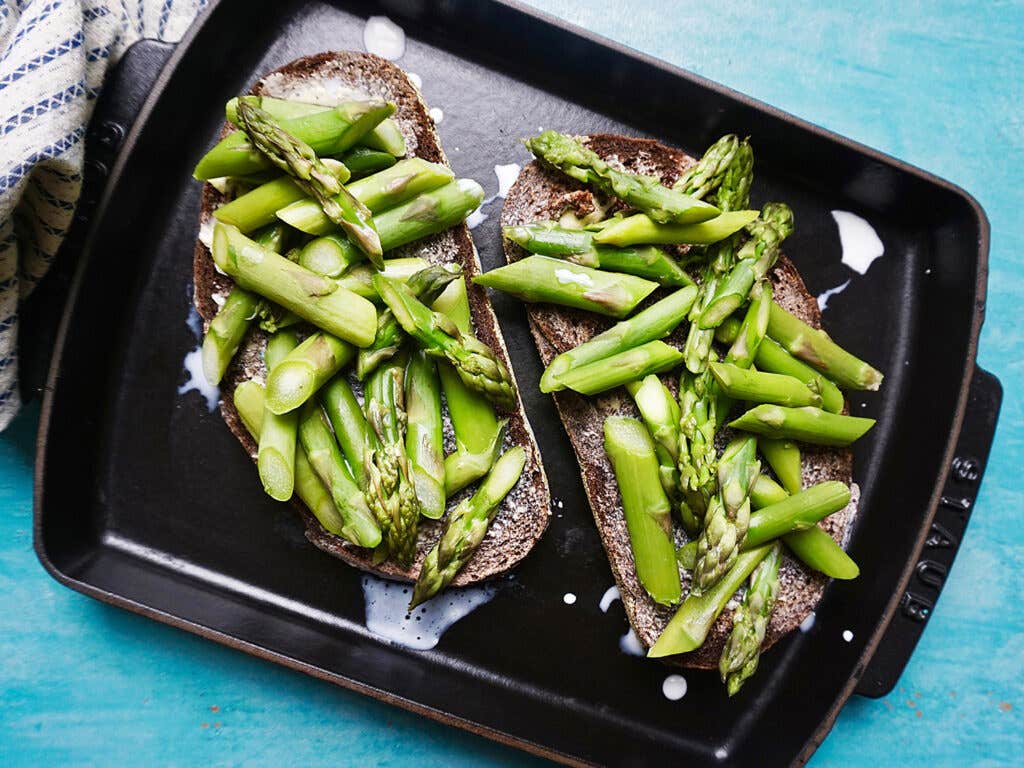
Move over, avocado toast—there’s a new brunch favorite in town! Perched atop buttery toast and drizzled with cream, blanched asparagus makes for a simple and comforting meal—and is so much greater than the sum of its parts. Get the recipe >
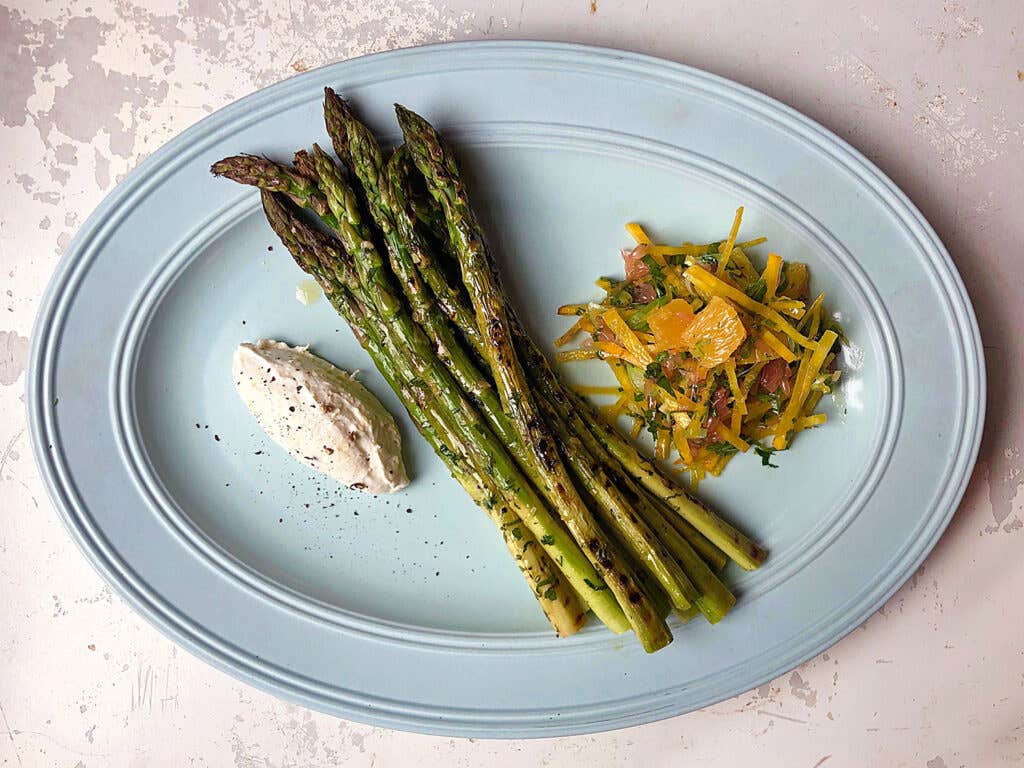
A grill makes quick work of cooking asparagus and gives the vegetable a welcome whisper of smoke. While it makes an excellent side dish as is, this recipe ups the ante with garlicky salsa verde, citrus-marinated golden beets, and creamy whipped ricotta. Get the recipe >
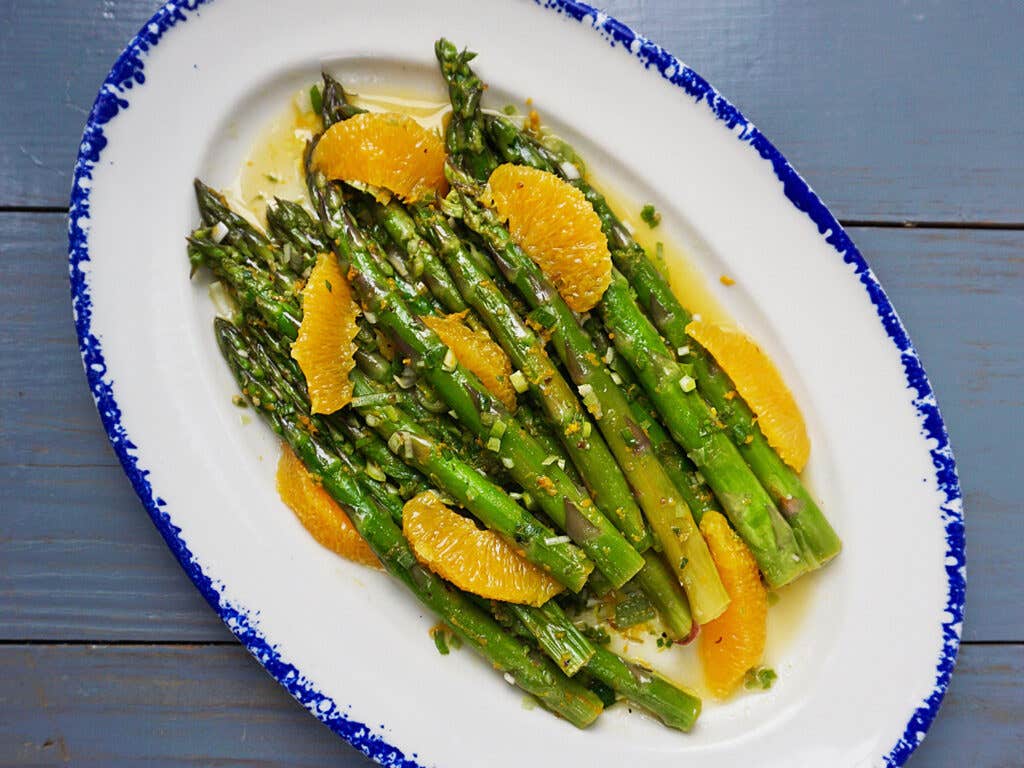
The oft-misunderstood microwave is an excellent ally for quick and precise vegetable cookery—and New York City chef Andrew Carmellini agrees. He quick-steams asparagus in the microwave until tender, then completes the dish with orange segments, scallions, and oregano. Get the recipe >
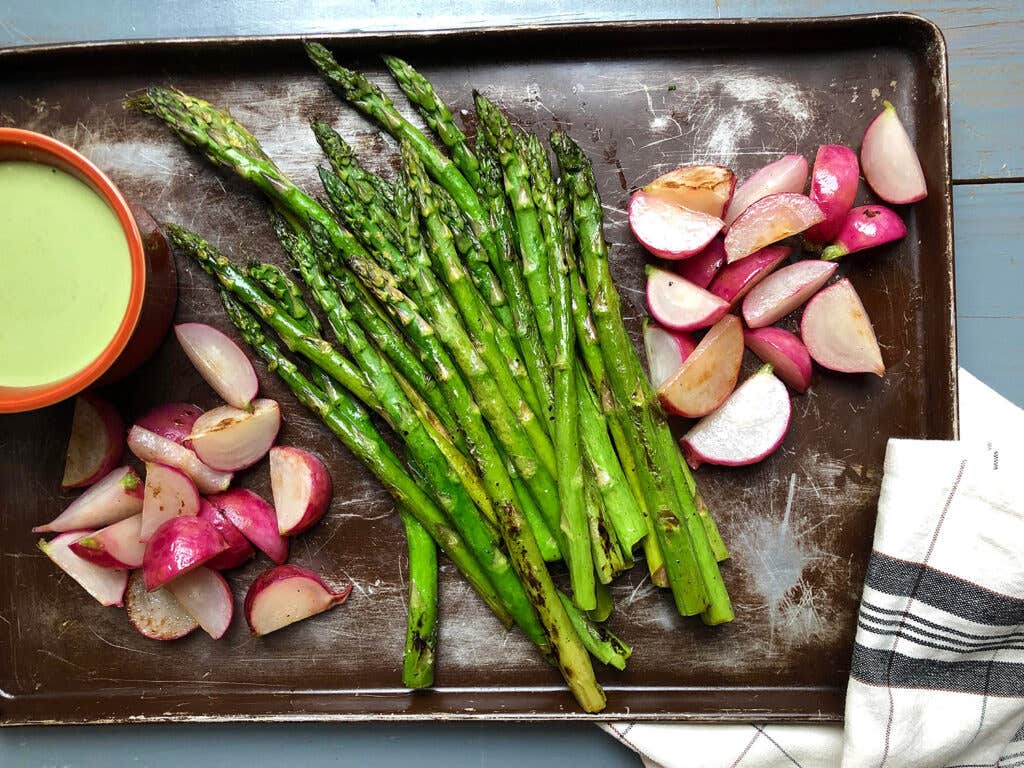
Asparagus shines when roasted in a hot oven—and before that summer heat kicks in, few techniques make for an easier dinner-party side dish. An herbaceous ranch-inspired tahini dressing (which can easily be prepared in advance) makes this simple preparation fit for entertaining. Get the recipe >
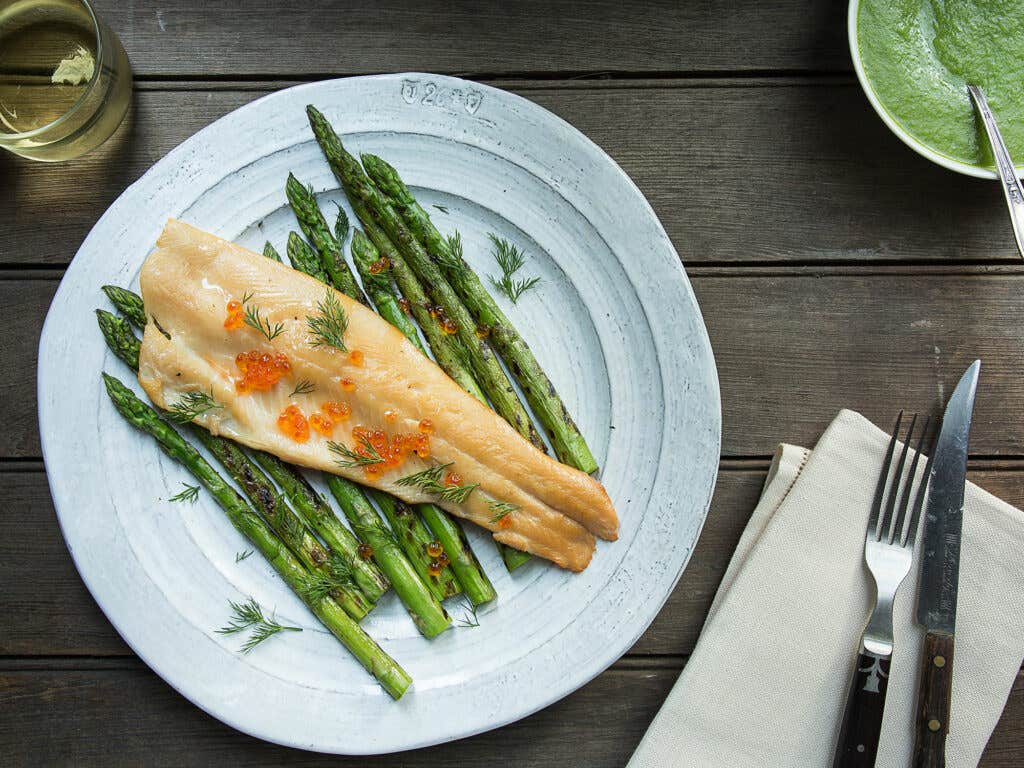
Charred, flame-kissed asparagus is the MVP in this recipe: it’s served whole alongside the stovetop smoked trout, as well as puréed into a verdant sauce with fresh dill and sorrel. Get the recipe >
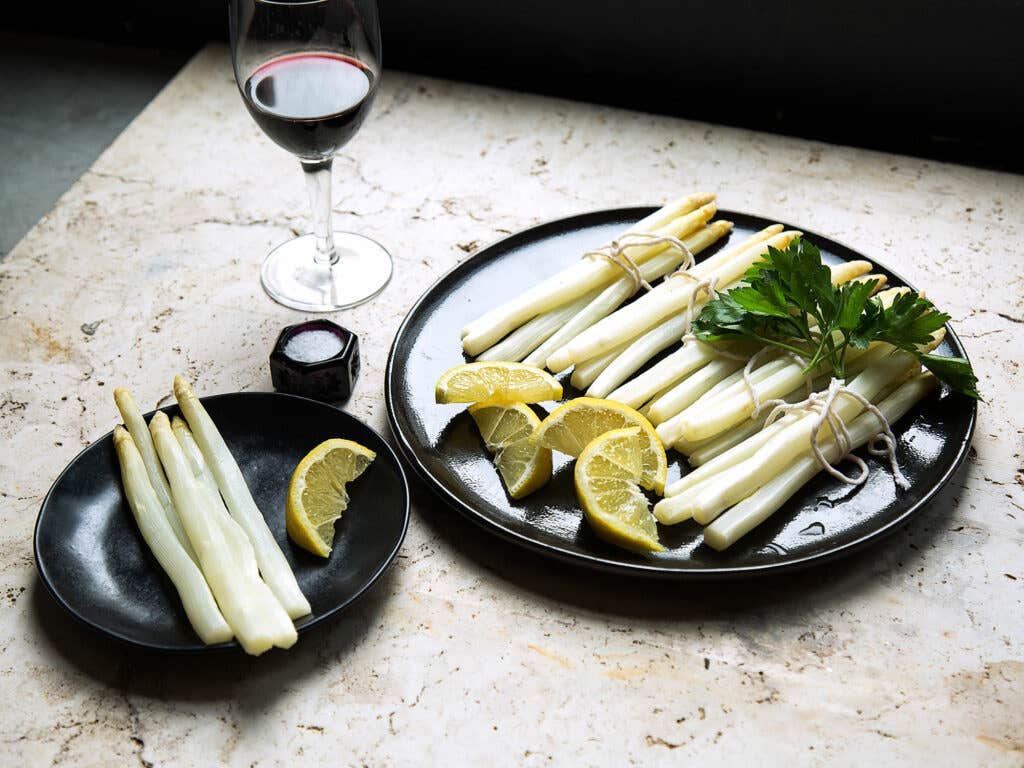
Simple is best when it comes to preparing this treasured vegetable: Remove the tough, bitter peel, then simmer in a pot of water with salt, lemon juice, and butter until perfectly tender. Get the recipe >
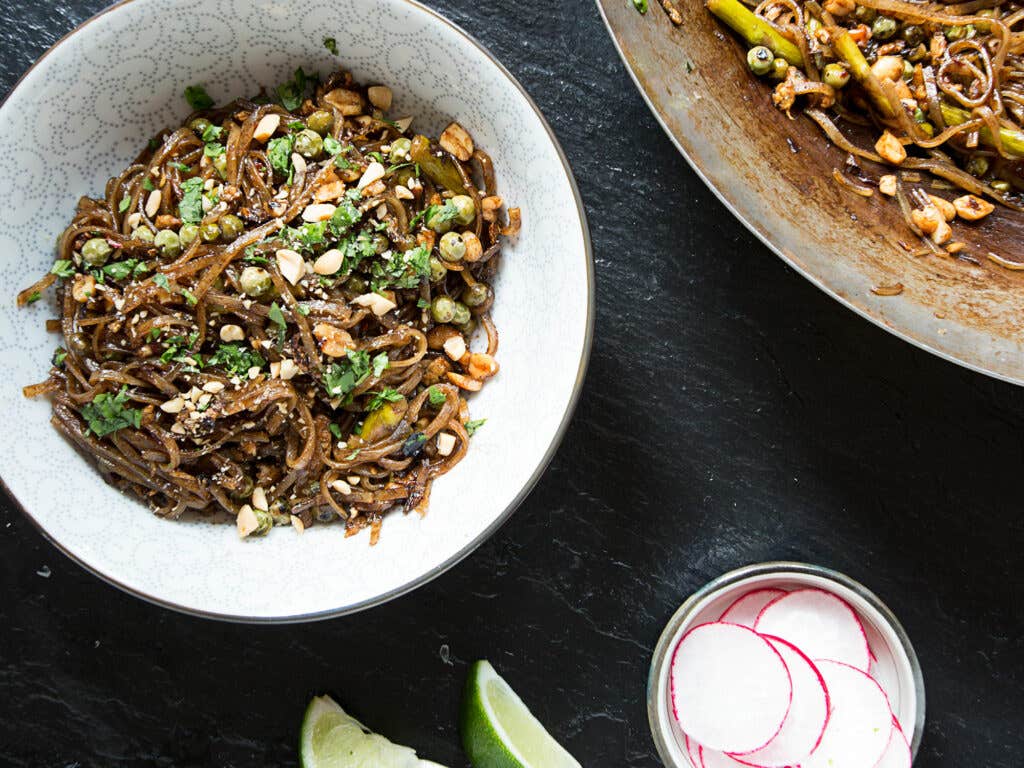
Everything you love about Thailand’s national dish but updated with spring ingredients! Asparagus, green garlic, peas, and radishes play beautifully with the classic savory, tart sauce. Get the recipe >
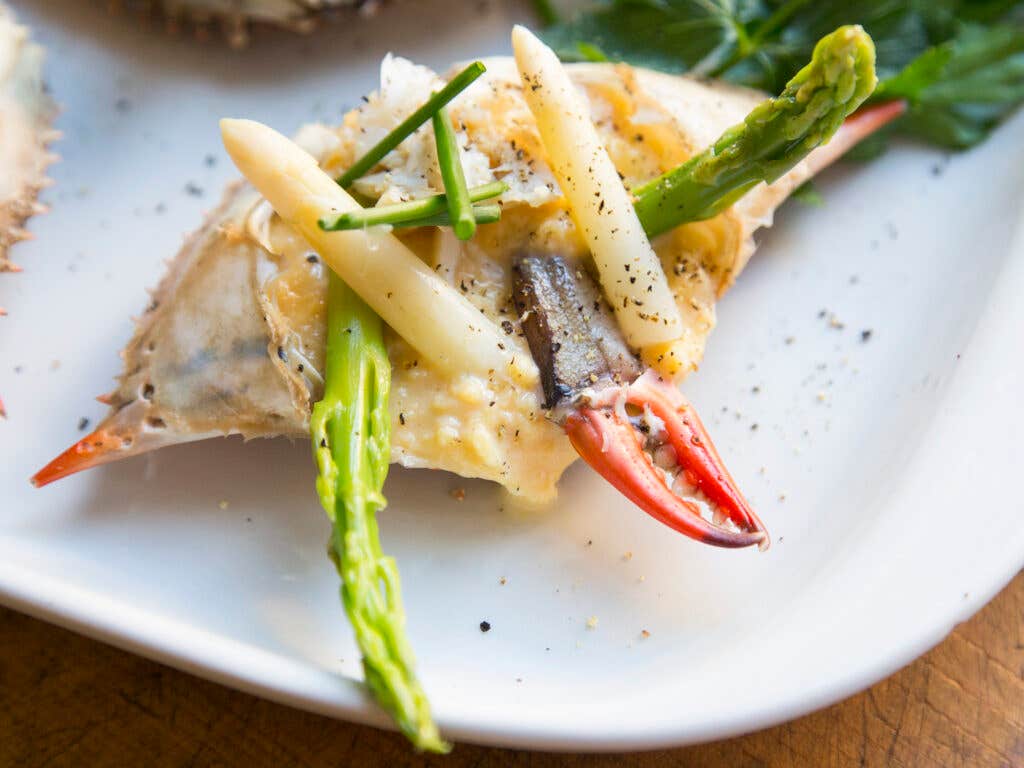
It doesn’t get more elegant than these custardy, slow-scrambled eggs served in crab shells. They’re topped with plenty of sweet crabmeat, both green and white asparagus—blanched to perfection—and a snip of chives. Get the recipe >
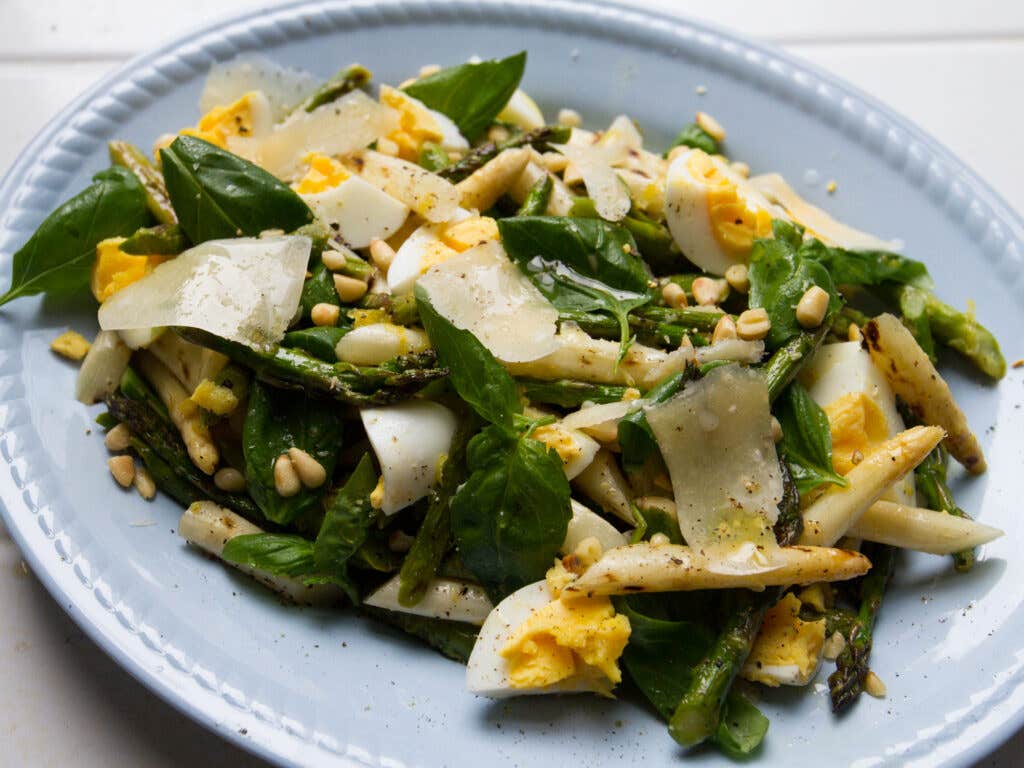
Smoky grilled green and white asparagus are bulked up with hard-boiled eggs and tossed with fresh basil, buttery pine nuts, bright lemon, and nutty parmesan in this sophisticated side. It works just as well for a spring dinner party as it does a summer cookout. Get the recipe >
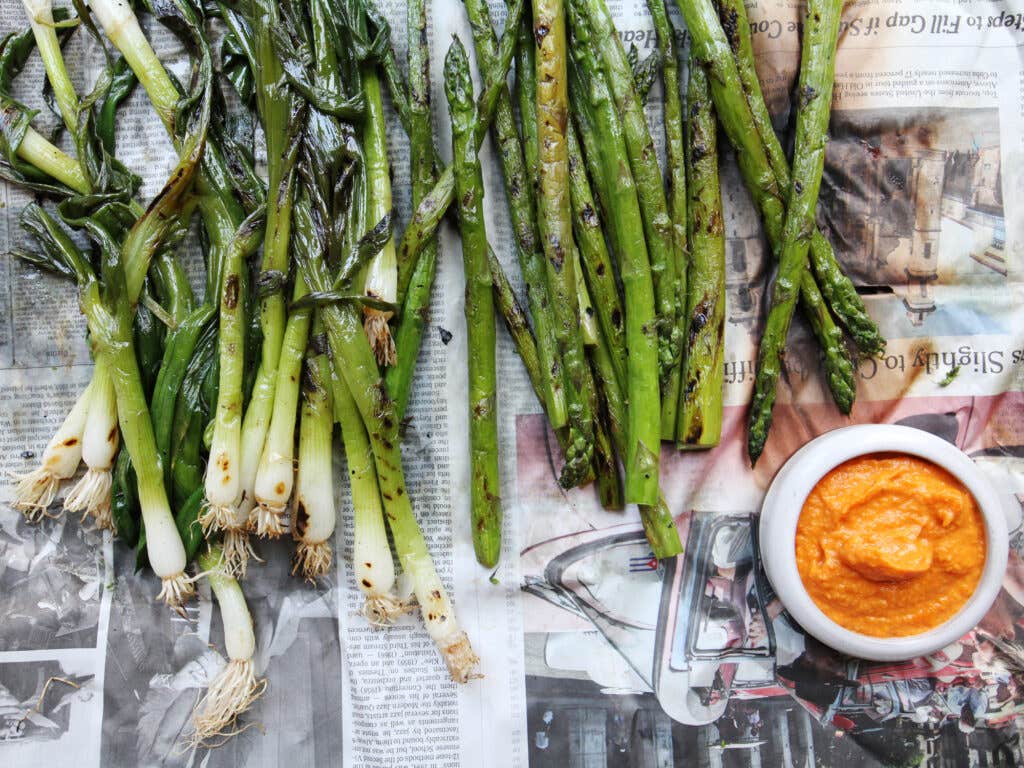
Asparagus joins another peak-season ingredient in this springtime dish from celebrated chef José Andrés: calçots, or Spanish green onions. They’re cooked together on the grill, then served with the smoky-sweet sauce of charred tomatoes and red peppers known as romesco. Get the recipe >
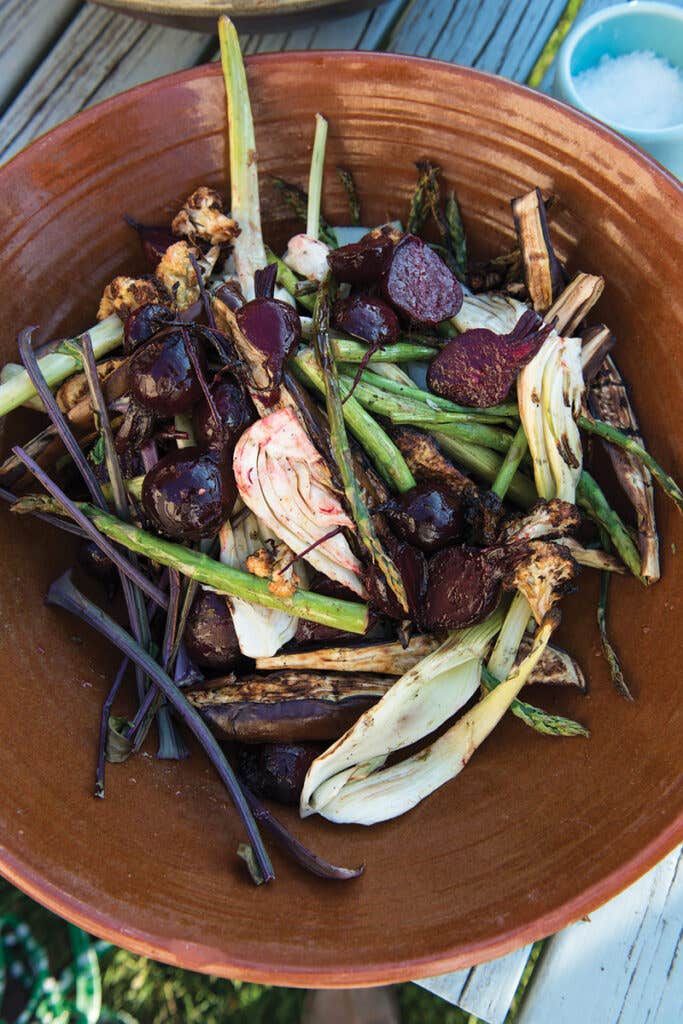
This versatile recipe comes to us from a Swedish writer’s Midsummer dinner menu. It calls for grilling asparagus along with beets, eggplant, cauliflower, and fennel, tossing everything with lemon juice and zest, and serving warm. Get the recipe >
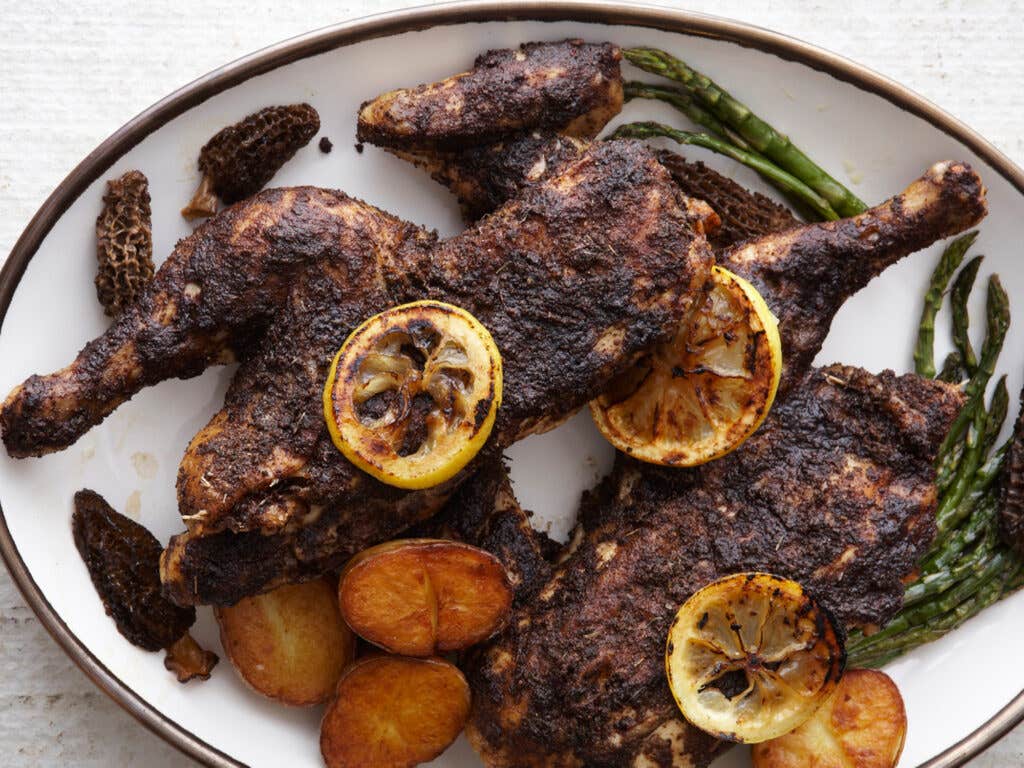
Asparagus is roasted right alongside the whole chicken, flavored with ground dried morels in this showstopping spring main. Charred lemons and crispy potatoes round out the earthy entrée. Get the recipe >
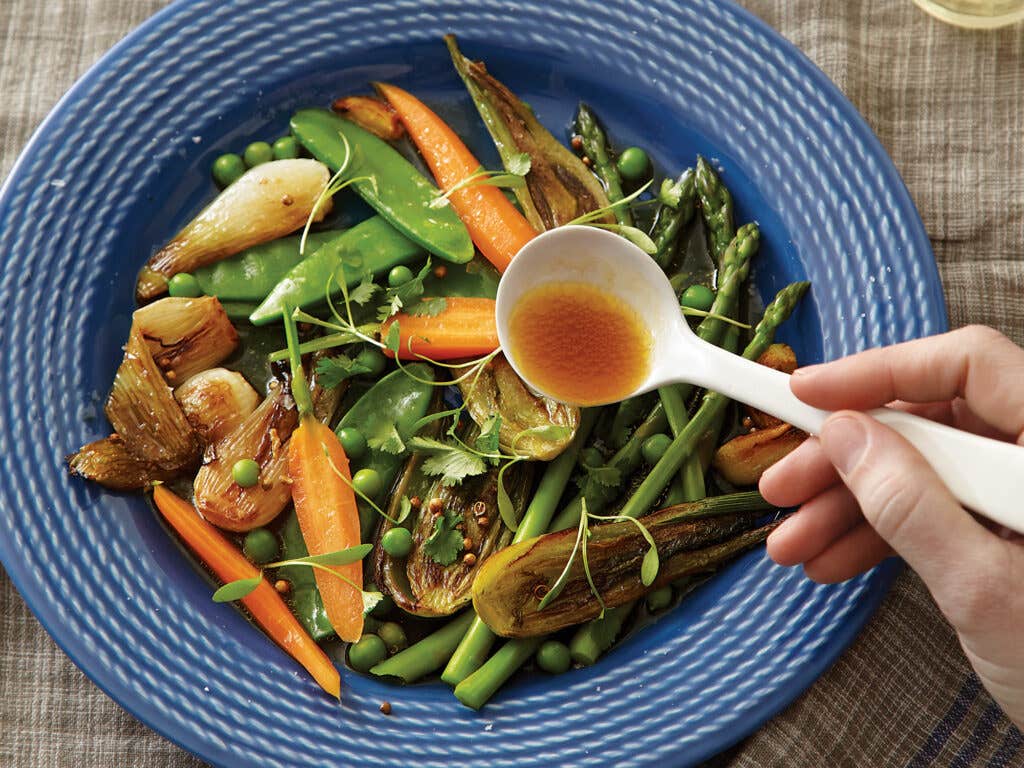
Crisp spring vegetables—think pencil-thin asparagus, baby carrots, snow peas, and more—meet a delicate, vanilla-scented broth in this light and bright Provençal classic. Get the recipe >
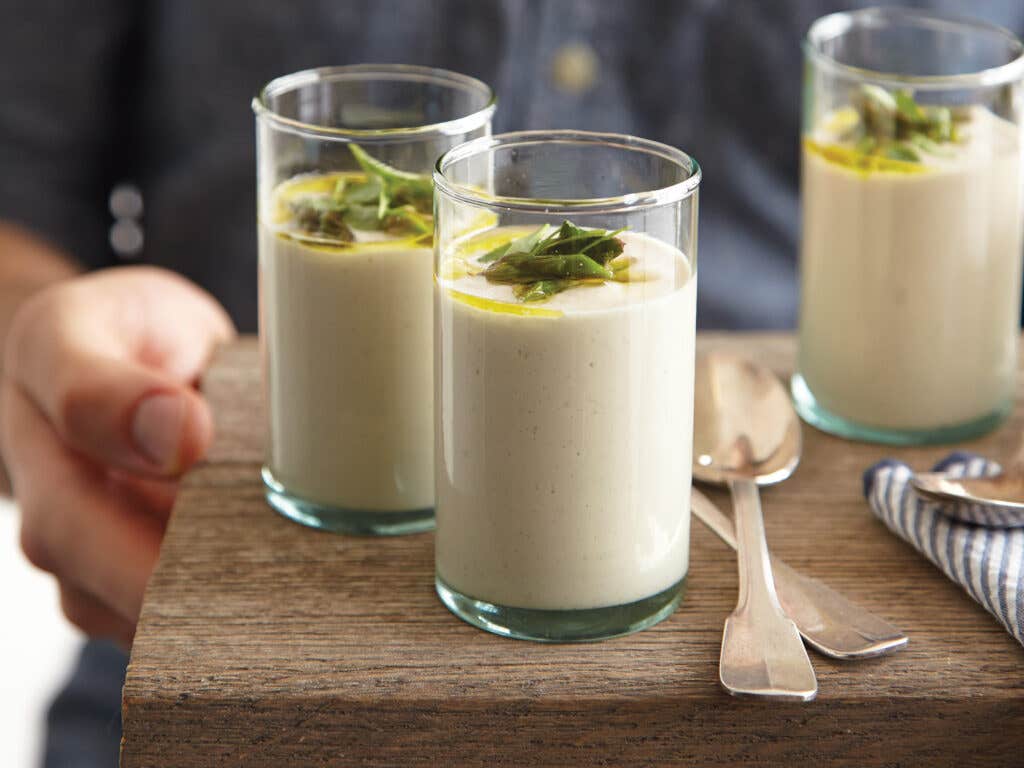
Asparagus is quick-marinated in a spicy-sweet cilantro-lime vinaigrette for the topping of this creamy cold soup. Get the recipe >
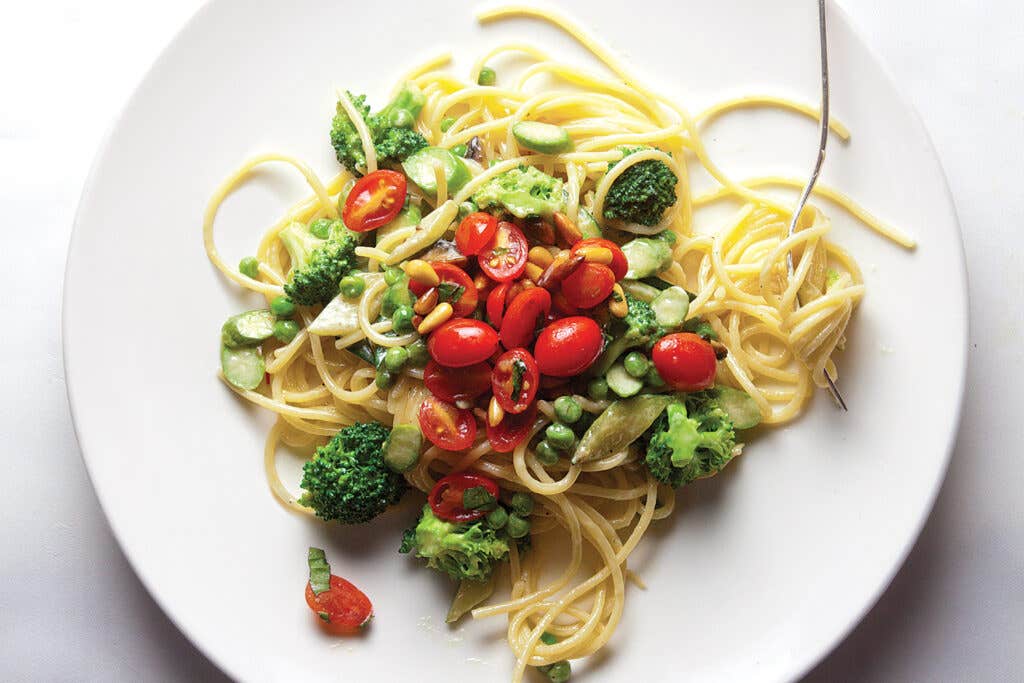
This iconic spring pasta dish from New York City’s legendary Le Cirque wouldn’t be complete without asparagus. It’s teamed with more seasonal vegetables—broccoli, peas, zucchini, tomatoes—and a rich parmesan cream sauce for an ultra-satisfying supper. Get the recipe >
Keep Reading
Continue to Next Story

